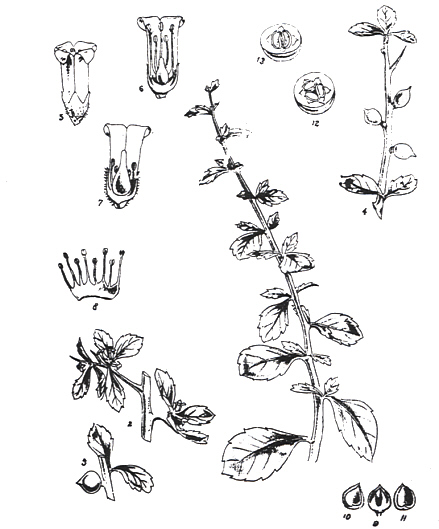

Zitierweise / cite as:
Carakasaṃhitā: Ausgewählte Texte aus der Carakasaṃhitā / übersetzt und erläutert von Alois Payer <1944 - >. -- Anhang A: Pflanzenbeschreibungen. -- Commifora wightii Arn. -- Fassung vom 2007-06-27. -- URL: http://www.payer.de/ayurveda/pflanzen/commifora_wightii.htm
Erstmals publiziert: 2007-06-27
Überarbeitungen:
Anlass: Lehrveranstaltung SS 2007
©opyright: Dieser Text steht der Allgemeinheit zur Verfügung. Eine Verwertung in Publikationen, die über übliche Zitate hinausgeht, bedarf der ausdrücklichen Genehmigung des Verfassers
Dieser Text ist Teil der Abteilung Sanskrit von Tüpfli's Global Village Library
WARNUNG: dies ist der Versuch einer
Übersetzung und Interpretation eines altindischen Textes. Es ist keine
medizinische Anleitung. Vor dem Gebrauch aller hier genannten Heilmittel wird
darum ausdrücklich gewarnt. Nur ein erfahrener, gut ausgebildeter ayurvedischer
Arzt kann Verschreibungen und Behandlungen machen!
Falls Sie die diakritischen Zeichen nicht dargestellt bekommen, installieren Sie eine Schrift mit Diakritika wie z.B. Tahoma.
Verwendete und zitierte Werke siehe: http://www.payer.de/ayurveda/caraka0001.htm

Abb.: Commifora wightii Arn.
[Bildquelle: Kirtikar-Basu, ©1918]
Dutt:
"BALSAMODENDRON MUKUL. Syn. Balsamodendron Agallocha,
Sans. Guggulu, Vern. Guggul. Beng. Hind.
Guggulu or Indian bdellium is obtained by making incisions in the tree, through which the gum resin exudes. According to Sanskrit writers, new or recently exuded guggulu is moist, viscid, fragrant and of a golden colour. It burns in the fire, melts in the sun and forms a milky emulsion with hot water. Old guggulu is dry and without flavour or colour ; it should not be used in medicine.
Guggulu is said to be demulcent, aperient, alterative and a purifier of the blood. It is used in rheumatism, nervous diseases, scrofulous affections, urinary disorders, and skin diseases. In rheumatism it is used in a great variety of forms. The following called Yogarāja guggulu is a favourite preparation.
Yogarāja guggulu. Take of plumbago root, long popper root, ājowan, seeds of Nigella sativa (kālājirā), bāberang seeds, seeds of Carum Roxburghianum (ajamodā), cumin seeds, Pinus Deodara (devadāru), Chavica officinarum (chavya), cardamoms, rock salt, root of Aplotaxis auriculuta (kushtha), root of Vanda Roxburghii (rāsnā). fruits of Tribulus terrestris (gokshura), coriander, the three myrobalans, tubers of Cyperus rotundus (mustaka), long pepper, black pepper, ginger, cinnamon, root of Andropogon muricatus (usira), yavakshāra (impure carbonate of potash), leaves of Pinus Webbiana (tālisapatra) and the leaves called tejapatra, one part each, in fine powder, bdellium in quantity, equal to all the above ingredients. Hub them together with clarified butter and preserve the preparation in an earthen pot smeared with clarified butter. Dose from a half to one tolā. It is given in rheumatic affections and other diseases supposed to be caused by deranged air, in unhealthy ulcerations, affections of the joints etc. Another preparation called Trayodasānga guggulu, is similar in composition to the above. It is made with thirteen aromatic adjuncts, hence its name, and is recommended for use in rheumatism affecting the loins and the sacrum. In rheumatism affecting the joints and bones the following preparation called Ādityapāka guggulu is used. Take of the three myrobalans and long pepper each eight tolās, cinnamon and cardamoms four tolās each ; powder the ingredients finely and soak for seven days in a decoction of the ten drugs, called dasamula (see Desmodium gangeticum). Then add forty tolas of guggulu and beat together into a uniform mass. Dose, half to one tolā.
Vatāri rasa. This preparation is used in paralysis and nervous diseases. To prepare, it take of mercury one part, sulphur two parts, the three myrobalans, three parts in all, plumbago root four parts and pure guggulu five parts. Rub them together with castor oil for twelve hours, then add to the mass the compound powder, called Hingvastaka (see Assafoetida), in weight equal to all the above ingredients, and again rub together for twelve hours. Dose, about half a drachm.
Kaisara guggulu. Take of pure bdellium, gulancha and the three myrobalans, each two seers, water ninety-six seers. First boil the gulancha and the myrobalans in the water till the latter is reduced to one-half, and strain the decoction; to the strained fluid add the bdellium and boil in an iron vessel till the whole is reduced to the consistence of treacle. Now add to it the following substances in fine powder, namely, the three myrobalans, each sixteen tolas, gulancha eight tolās, ginger, long pepper and black pepper, each six tolas, bāberang seeds four tolās, root of Baliospermum montanum (danti) and Ipomoea Turpethum. (trivrit), each two tolās, and beat them together into a uniform mass. Dose from a quarter to one told, to be taken with a decoction of madder, tepid milk or water. This medicine is said to be useful in various skin diseases from deranged or vitiated blood. It is said to act as an alterative tonic and to improve the nutrition of the body.
Sadanga guggulu. In affections of the eyes with pain, swelling and inflammation, (rheumatic ophthalmia?) bdellium is recommended to be given with a decoction of the three myrobalans, root of Momordica dioica (patala), nim bark, and the loaves of Adhatoda vasica (vāsaka). A similar preparation is recommended for secondary syphilitic ulcerations. In unhealthy ulcerations, the following, called Amrita guggulu is recommended. Take of gulancha, root of Momordica dioica (patala), the three myrobalans, long pepper, black pepper, ginger, and bāberung seeds in equal parts, guggulu, in quantity equal to all the above ingredients and beat them together into a mass. Dose about a drachm every morning."
[Quelle: Dutt, Uday Chand: The materia medica of the Hindus / Uday Chand Dutt. With a glossary of Indian plants by George King. -- 2. ed. with additions and alterations / by Binod Lall Sen & Ashutosh Sen. -- Calcutta, 1900. - XVIII, 356 S. -- S. 132ff.]